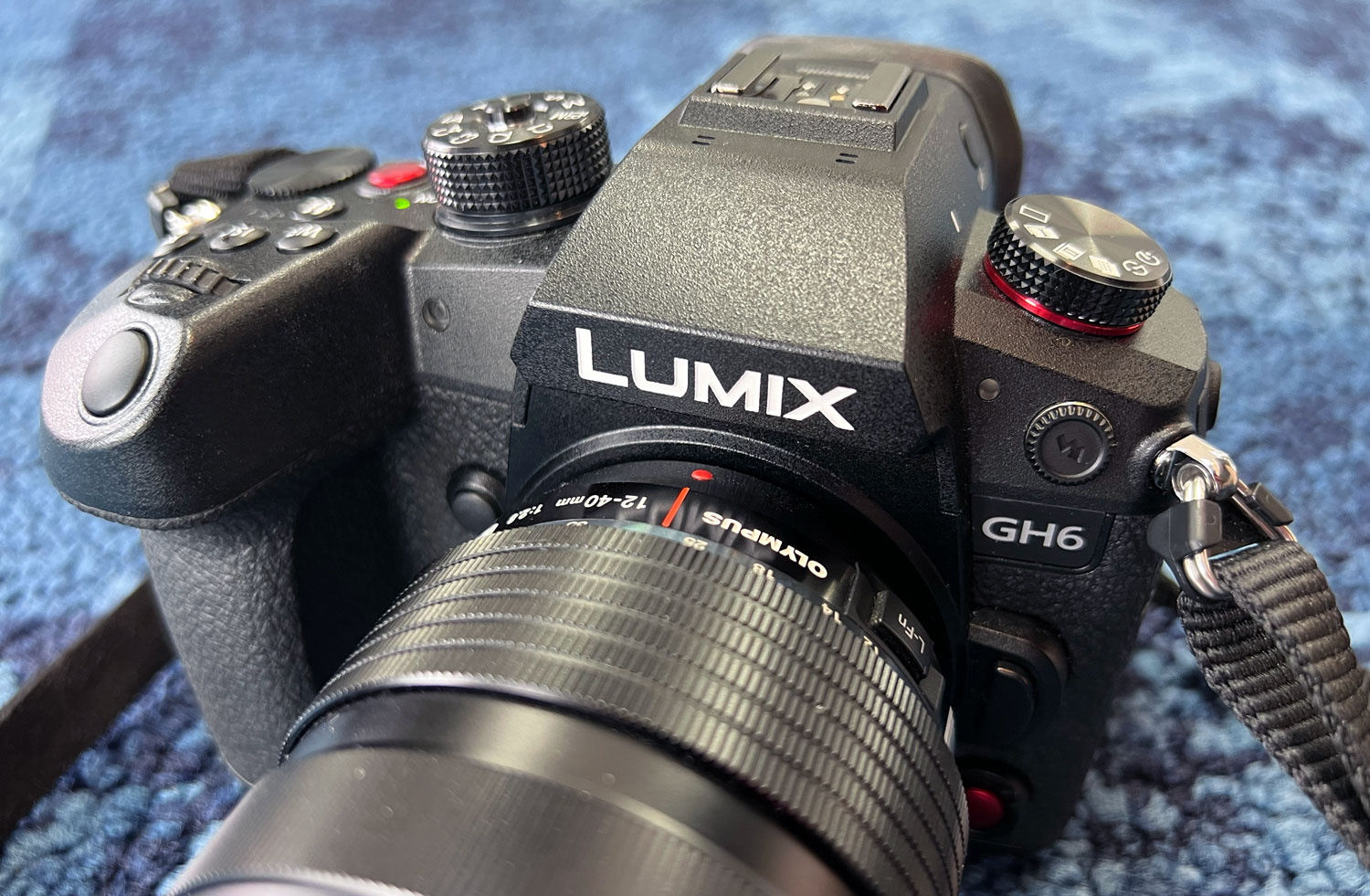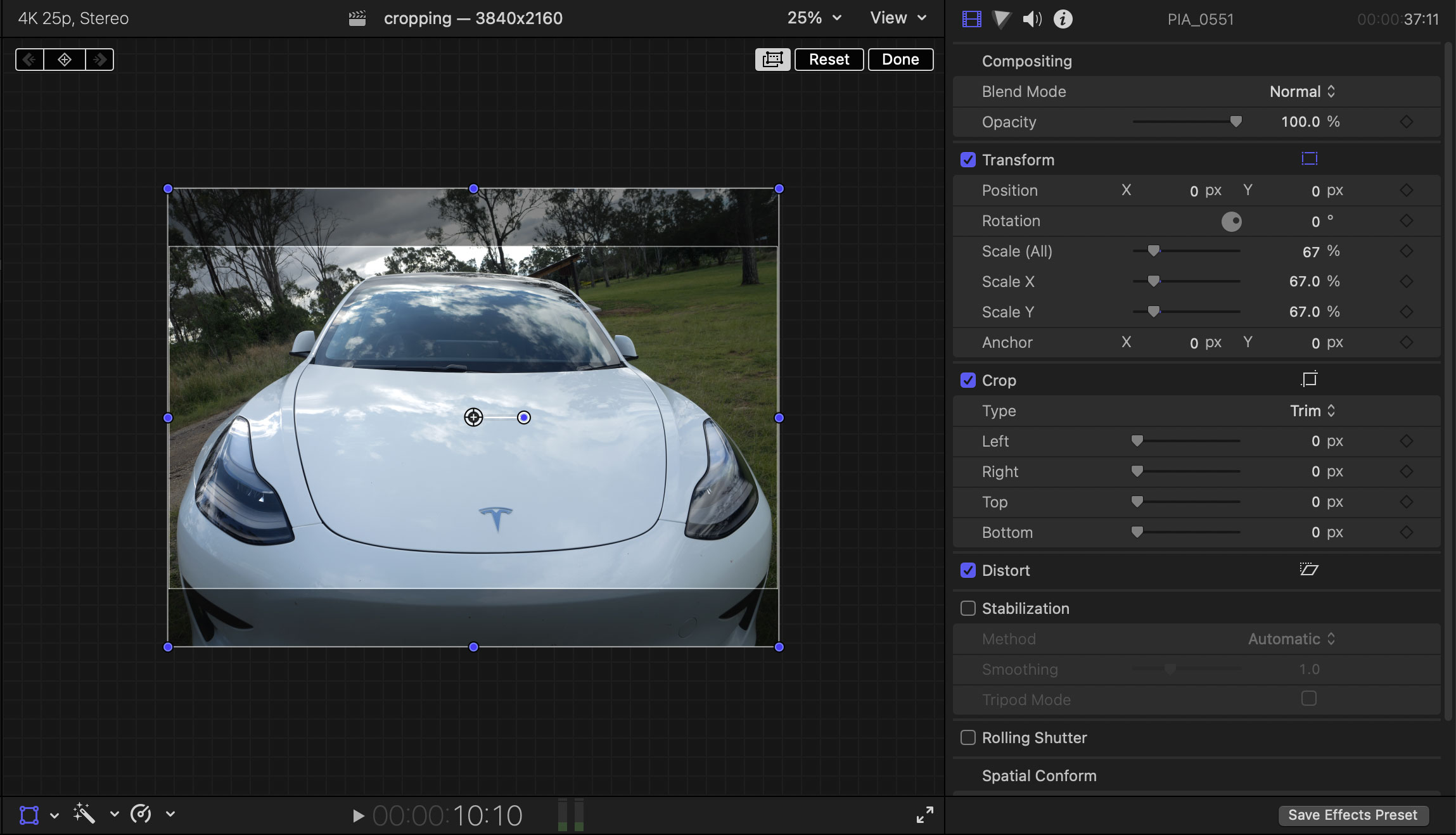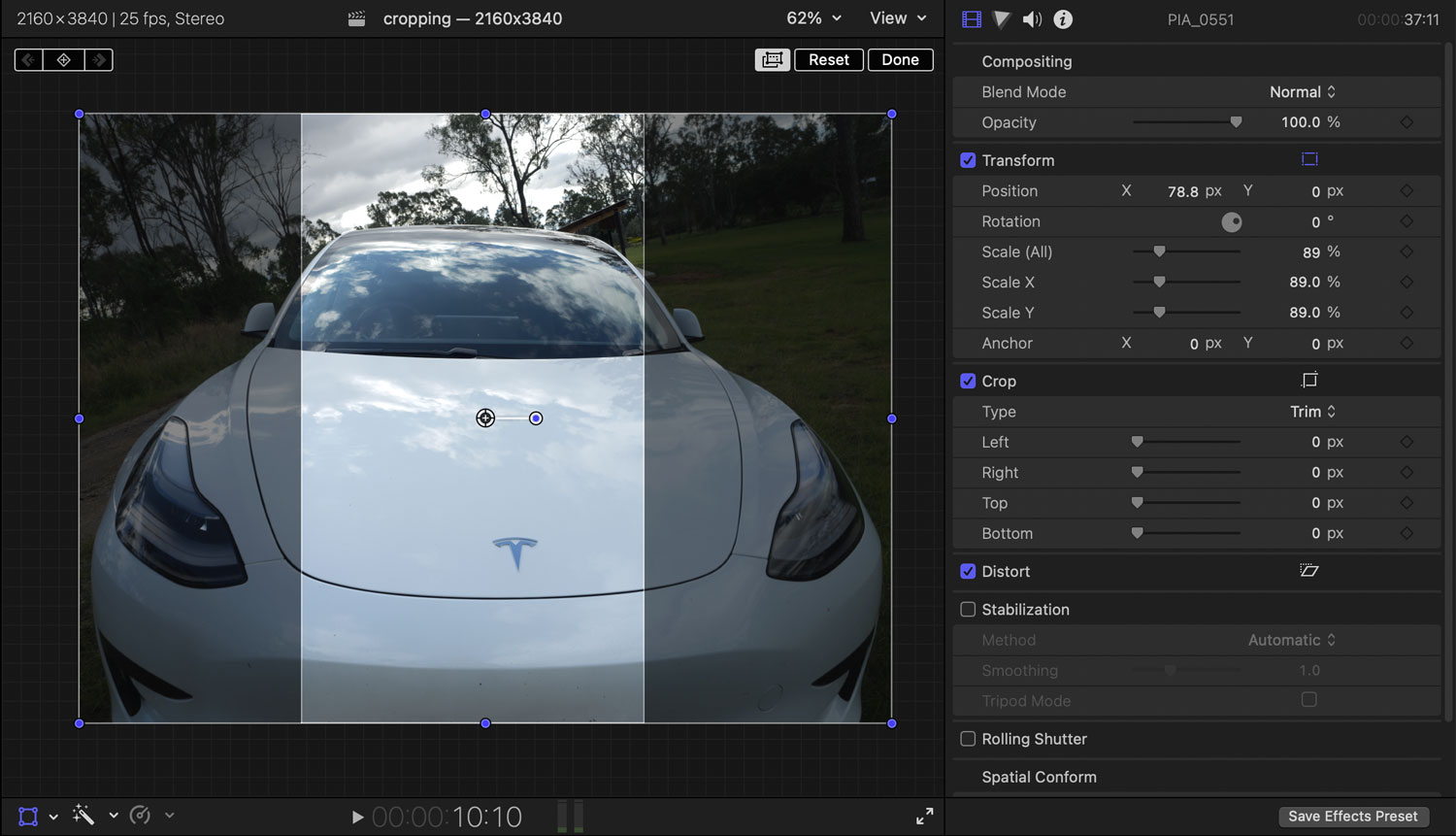
Introduction
If you’re a GH5 shooter like me, you’ll probably have been waiting impatiently for the Panasonic Lumix GH6 — through pre-announcements, delays, and its eventual release in April 2022. While the GH6 is an obvious upgrade path to any videographers in the Micro Four Thirds (MFT) world, is an upgrade something you should consider now, or down the path, or throw in the towel and jump to a larger full-frame option? The competition has never been stronger; there’s the S5 and S1H from Panasonic, plus capable new cameras from Sony, Canon, Blackmagic and others. So you’ve got choices.
Plenty of people have posted their video reviews already, and I’ll leave the detailed image analysis to them. In this five-word review, I’ll take you through five important features of the camera:
- Fidelity
- Options
- Handling
- Power
- Workflow
Fidelity
A few numbers to start. The GH6 can record 5760×4320 pixels, at 24, 25 or 29.97 fps, in 10-bit color, at a reasonable data rate of 200Mbps, for as long as you want. Crop that 4:3 open gate frame back to a 17:9 aspect, and you can slum it at 5728×3024 while doubling all those maximum frame rates, still in 10-bit, at 300Mbps. There are many 4K and C4K options too, all downsampled from the full 25MP sensor, and there’s hardly any cropping involved anywhere.

While an open gate 4:3 frame is perfect for shooting once and then cropping to 16:9 and 9:16 deliverables, the image is also detailed enough to allow a serious punch-in. With all spatial conforming disabled, I can fill a 4K frame by scaling the original image to 66.6%, or moving the other way, scale it to 150% to use the actual 1:1 pixels recorded. If you’re still delivering 1080p then you’ll have even more flexibility to play with, but either way, all this extra resolution means you can shoot a little wider, then reframe at will.

Oversampling is not new; you may have been shooting 4K for 1080p delivery for some time and enjoying the freedom to zoom and pan your shots in post. But times change, and as delivery standards step higher, if you still want to reframe in post you’ll want to shoot higher than 4K.
Alongside the increased spatial resolution, temporal resolution has also been boosted: you can record 4K at 120 fps if you need to, or 300 fps at 1080p if you’re willing to sacrifice some fidelity. As on the GH5, “normal” frame rates go up to 50fps in PAL mode or 59.94 in NTSC, while the “variable frame rate” option enables much higher speeds and lower speeds (down to 1fps for an easy timelapse). The tiny sensor and fast processor on an iPhone has offered 240fps for some time, so it’s great to see a flexible mirrorless camera offering useful options here too.
Though 10-bit isn’t new in the GH line (you could shoot 10-bit in many modes on the GH5) it’s the default rather than the exception on the GH6. There’s hardly any 8-bit video on offer, and you’ll have to dig deep to find a couple of legacy 8-bit MP4 settings that match the GH5’s most common shooting modes. Like the GH5, there are 4:2:2 and 4:2:0 options available, so if you need the increased color resolution, you can still have it — as long as you don’t want high-speed capture at the same time.
Side note on Chroma Subsampling
If you’re not across 4:2:2 vs 4:2:0 vs 4:4:4, the difference is in a video’s chroma (color) resolution when compared to the luminance resolution. For most purposes, the best capture you’ll see is 4:2:2, meaning there’s chroma information for 50% of the luminance pixels — and you’ll need this for higher-end productions or more extreme color grades. Many other cameras need an external recorder to capture 4:2:2 at all, but the GH6 can do it in both the ProRes and H.264 codecs.
More commonly used is 4:2:0, chroma information for 25% of the luminance pixels. We don’t see color as clearly as luminance, so this is a compromise worth making. You’ll probably only encounter 4:4:4 (full chroma resolution) for computer-generated images or pre-keyed footage — possibly using ProRes 4444 to include the alpha channel too.
Luckily, it’s pretty easy to manage all this complexity, through comprehensive and welcome options.
Options
The sensible menu structure has long been a strength of Panasonic cameras, and the GH6 manages to cram even more options into an even nicer multi-level menu structure. While the GH5 was (more or less) one level deep, with each main menu potentially several pages long, the GH6 breaks up each sub-page with a separate icon, and it makes a good thing even better.
For video, there are several containers on offer (MP4, MOV, Apple ProRes) and within each of those, many options for resolutions, with possible frame rates and other options. You’ll want to choose MOV for the widest range of options, but MP4 if you need the smallest UHD file size (72Mbps). While ProRes is clearly called out, it’s not obvious which format choices use H.264 and which use HEVC. Within the MOV container, 422 means H.264 AVC, and the 420 options all use HEVC. In MP4, it’s all 420, so 8-bit means H.264, and 10-bit means HEVC.
Luckily, you only have to engage with this choice stress when setting up the camera initially. Once you’ve settled on your choice of codecs, containers, possible frame rates, Long-GOP, All-I and ProRes — did I mention you can record to ProRes? — pick your favorites and store them in “My List”. There’s no need to pick a compatible container, then dive into the formats to scroll through many pages of options; just choose one option from one menu and everything changes.
It’s a capable camera in many ways. If you want to work with HDR footage, you can record in HLG or V-log. If you want to increase dynamic range a little, you can use the Dynamic Range Boost mode — though this does send the minimum ISO all the way up to 2000, and doesn’t give a whole lot in return. The 25MP sensor gives a useful, if minor boost in resolution for stills, but if you need more, the camera will happily merge a burst sequence, even handheld, for a 100MP high resolution still. Beware: a moving subject can’t be captured in this way, and if you shake while capturing, merging the high-resolution shot is likely to fail, so a tripod is still the safest bet.
Handling
Physically, it’s satisfyingly heavier than a GH5, in the same way that a GH5 feels more serious than a G7. The added heft still feels good in the hand, though I wouldn’t want it to be much heavier. The tilty-flippy screen can now tilt in place as well as off to the side, making it the most versatile screen I’ve used on a camera. You can mess with the screen while cables (including full size HDMI) are connected on the side, and it’s clear and easy to use. The in-body stabilization is great, even better than on the GH5, and if you ever work handheld, you’ll appreciate it.
Two card slots (one SD, one CF Express Type B) allow you to use one for video and one for stills, use one card first and the other if it’s full, or record the same thing to both cards. While CF Express B cards are still expensive, they are fast enough to allow ProRes (5.7K @ 1.1Gbps) and you’ll need at least one (from Panasonic’s short approved list) if you want to use backup or relay recording. Buying a card reader is optional, though; just plug the camera into a computer and the cards will mount — it works, but a regular card reader will be faster.
A dedicated button for audio settings lets you see levels and change anything you need to, which is very welcome. If you have Panasonic’s XLR adapter (the same one used with the GH5 and their other cameras) you can record a two-channel minijack as well as the two XLR mics, for up to four separate channels of audio. If you can get great results without an external audio recorder, that’s one less thing to manage on set. You’re also less likely to miss a shot because you think you’re recording when you’re not, because there are tally lamps front and back, plus an unmissable red border around the whole screen.
Operationally, the GH6 builds on the excellent base in the GH5. Though the deeper menus are well organized, a professional camera operator needs dedicated buttons for their favorite features, and there are more of these than ever. Several buttons around the camera can be reprogrammed for instant access to a specific feature.
I’ve set up mine for Waveform, Focus Peaking, Frame Marker (to see 16:9 guides while recording open gate), Zebra, Stabilise, Contrast Boost and Level Guide, but I’ll likely swap it around as I work more with the camera. It’s easy to change your mind; just hold down a button and pick something else. You might want more focus tools, or quick access to Synchro Scan for fractional shutter speeds, or Focus Limiter — there are pages and pages of options.
Besides My List and the huge selection of custom buttons, you can save the entire state of the camera (including custom buttons, video modes, and everything else) to one of the Custom Modes. There are four dedicated dial options (C1, C2, C3 and C4) while the last C4 actually hides up to 10 modes: C4-1, C4-2… through C4-10 — though you can hide this complexity if you wish. That’s right, you can even limit how many custom modes you want to see. Simplicity within complexity.
Lastly, this wouldn’t be a Panasonic review if I didn’t talk about autofocus, long considered the weakest point of the GH5’s video performance. While not everyone uses or cares about autofocus, this camera has made huge improvements over the GH5, and it’s good enough for most shooters in most circumstances. If you really need to limit visible pulsing while the camera hunts for focus, you can now set limits on how far the camera will seek back and forth — for example, allowing the focus to chase a subject that leans forward, but ignore any movement backward. The now-decent autofocus makes the GH6 a much easier camera to live with for me, but you can continue to ignore it if you don’t need it.
Power
While this is a powerful camera, this point isn’t about how many pixels it can manage. It’s just that the power management has improved to the point where you can use USB-C to charge and run the thing at the same time (if your power source can deliver 9V at 3A). This is revolutionary for anyone covering events where continuous recording is essential, but everyone can benefit from needing far fewer batteries, and needing to change them far less often. That’s doubly useful if you’re mounting your camera in such a way that the battery compartment is hard to reach, but on a recent shoot it meant I could just run a cable to a USB battery in my pocket, and the camera remained fully charged the whole time.
This is not Panasonic’s first camera to support USB-PD (the G9 and GH5 Mk2 also support USB power) but the original GH5 did not have this, and I’ve always wanted it. While it’s always been possible to use a dummy battery to provide DC power to Panasonic cameras, if power is lost while recording (power failure, someone tripping over a cable) then your entire current shot will be lost as it hasn’t been “finalized” properly. When someone’s been speaking for an hour or more, I’m itching to stop recording, but simply unable to do so. And while I’ve never actually lost a recording to due power failure, I’ve been keenly aware at the possibility. I didn’t need the stress, and it’s now just gone.
You can pull the USB-PD cord out and reinsert it while the camera is in use, during recording, with no issues at all. Note, however, that you can’t pull the battery out while powering the camera with USB-PD — a battery must be inserted to use the camera. That limitation means that while you can use a dummy battery with the GH6, and there’s even a rubber-covered hole in the battery door to help you do this, if there’s any risk of DC power failure, you might not want to bother.
Lastly, I really do appreciate that even though the GH6 uses a newer, more powerful battery (BLK-22) you can still use your older GH5 batteries (BLK-19) with a few limitations on the video side. Physically the batteries fit in fine, but the camera blocks the newer, higher resolution (5.7K and 5.8K) modes with an older battery inserted. Resolutions up to C4K work fine, and still photos don’t face any restrictions, so you may be able to re-use your old batteries at least part of the time if you want to.
Workflow
Every workflow is different, and the video industry has become such a wide, broad church over the last few years that there’s no one solution for everyone. Personally, I need my shots to be high resolution (oversampled), easy to capture, and easy to work with in post. I don’t want to have to transcode anything, I don’t want to make proxies, and I don’t want a shoot to take up terabytes of space. Sometimes I’m handheld, sometimes on a gimbal, and sometimes I need to record for hours at a time on a tripod.
On the GH5, I got very used to shooting UHD at 100Mbps, and my shots working perfectly, the first time, even in multicam, live on a Final Cut Pro timeline. But the GH6 has moved most of its formats from H.264 to HEVC, notoriously harder to work with than H.264 — so do you need to transcode now? Happily, no. On an M1 Max-based MacBook Pro, both HEVC and ProRes 5.8K files play back perfectly smoothly, both in FCP and in Adobe Premiere. But they’re even fine on an older Intel-based iMac, at least in FCP. It’s a bit gobsmacking that compressed 6K footage plays back just fine on a computer from 2017, but it’s great to see nonetheless. No transcoding, no proxies, no problem. (If you’re still wary of Long-GOP footage, you probably shouldn’t be.)
So then, if HEVC works well at 200Mbps, why would you want to use ProRes at five times the data rate? One reason: the color resolution is 4:2:2 rather than 4:2:0, and you may need to shoot 4:2:2 for client requirements. Maybe your workflow is standardized on ProRes to avoid poor experiences with tricky codecs — and that’s totally fair. Since HEVC works for me, and I’ve struggled to spot the difference between HEVC and ProRes 5.7K footage, I’ll save the space. Perhaps I’ll jump up to ProRes for more challenging green screen shoots.
Certainly, ProRes is a standard that’s well supported by many apps on many platforms, and it’s going to perform well on machines that can’t handle HEVC. But don’t overlook the ongoing costs in transfer time and expensive CF Express cards. A future firmware update promises to bring direct-to-SSD recording, hopefully making that far less painful, but you’ll likely spend more on batteries if you can’t the USB port for power. Long term, you’ll also still be stuck archiving five times as much footage as HEVC.
Conclusion
Numbers aside, tech aside, does the image look good? Yes. It’s more detailed than the GH5 and offers slightly more dynamic range. If you’re used to a full-frame sensor (and especially if you like a really shallow depth of field) then you’ll probably want to stay there, but if you’re in the MFT world already, the GH6 is a great upgrade. Panasonic recently released a 9mm f/1.8 (probably the perfect real estate and vlogging lens) so they’re not walking away from the platform, and it’s not impossible to get shallow shots on MFT either.
Compared to a full-frame camera, it’s not quite as good in low light, and the smaller sensor means more is likely to be in focus. Compared to a Canon or a Sony… it’s not quite as good at autofocus, but handling and workflow are nicer. Compared to a Blackmagic… it doesn’t have any RAW options, but the battery is far easier, lens distortion is automatically corrected, most media files are far smaller, and the screen can move.
There’s still a solid place in the market for the GH series of cameras, and not just for those who prefer their lenses small and light. Every camera has strengths and weaknesses, and there are many factors at play, not least price. And the price is pretty reasonable, especially when you consider the heights to which some other manufacturers are pushing their prices.
Also on the plus side: the faster, smaller sensor means that there’s almost no rolling shutter, and it won’t overheat. Stabilization is excellent, which makes it a great run-and-gun option. ProRes support enables higher-end workflows, while the easy-to-edit HEVC footage hits just the right balance between space requirements and image quality — something not all manufacturers seem to care about.
At the end of the day, if you have any kind of investment in MFT glass, and you’re happy with the kind of footage you’ve been getting with it, then the GH6 is a solid upgrade or expansion to your kit. Other gear might have its own advantages, but it won’t have everything that the Panasonic Lumix GH6 does. It’s already making my shoots easier. I regret nothing. Enjoy.

